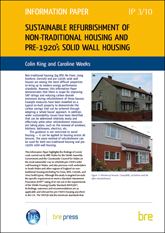Cart (0)

Book
Sustainable refurbishment of non-traditional housing and pre-1920's solid wall housing Downloadable version
Publisher
BRE Electronic Publications
Author
Colin King and Caroline Weeks
Format
A4, 12pp
Subject / Keyword
IP 3/10, Information Paper 3/10
Published Date
04-Jan-2010
ISBN
9781848061194
This Information Paper demonstrates that there is scope for improving SAP ratings and reducing carbon dioxide emissions during refurbishment of non-traditional and solid wall houses. Non-traditional housing (eg BISF, No Fines, Laing Easiform, Cornish) and pre-1920s solid wall houses are among the most difficult to bring up to modern energy performance standards. Example measures have been modelled on a typical property to demonstrate the carbon savings that are possible by taking a whole house approach. Other sustainability issues can also be addressed relatively easily during refurbishment, such as renewing windows, kitchens, bathrooms and electrics. This guidance is not restricted to social housing but can be applied to housing across all tenures. Contents Background Internal or external improvements? Assumed minimum aspirations of the refurbishment Standard assessment procedure The baseline/as-built house Reducing energy demand through refurbishment - The Building Regulations scenario - The Best Practice scenario Implications for fuel poverty Alternative energy - Biomass - Air source heat pumps - Solar thermal panels - Photovoltaic panels and wind power Wider sustainability considerations - Emissions other than carbon dioxide - Daylighting - Life-cycle assessment of material specifications - Responsible sourcing of materials - Provision of space for household recycling storage - Energy-efficient lighting - Energy efficient white goods - Reduced potable water use Conclusions and recommendations References Further reading from BRE
Book
Sustainable refurbishment of non-traditional housing and pre-1920's solid wall housing Downloadable version
List Price £ 13.00
